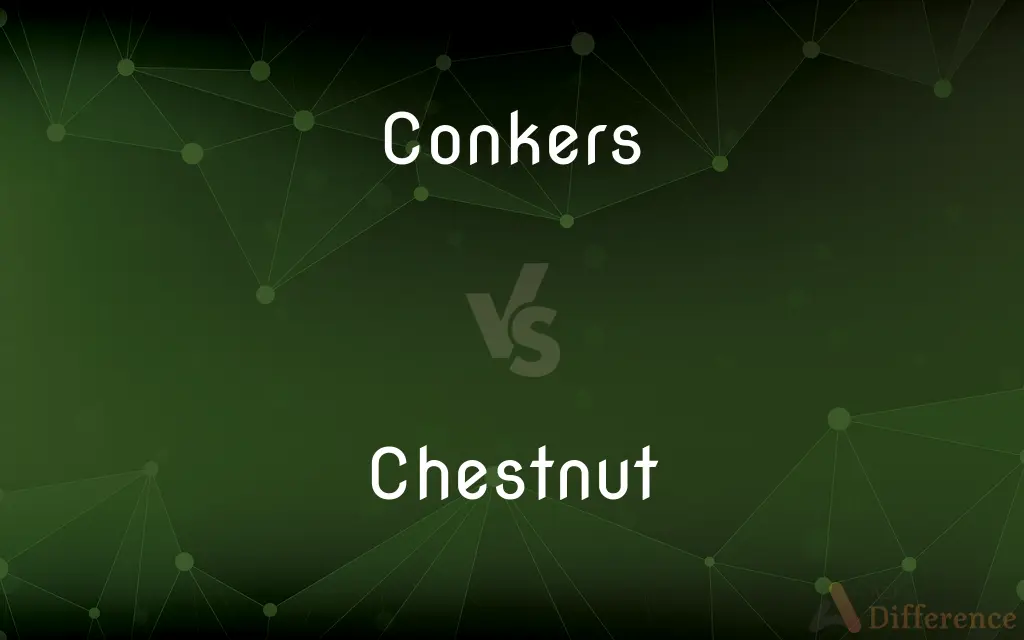Conkers vs. Chestnut — What's the Difference?
By Tayyaba Rehman & Maham Liaqat — Updated on April 20, 2024
Conkers, the seeds of horse chestnut trees, are inedible and used in games, while chestnuts, from trees of the genus Castanea, are edible and culinary staples.

Difference Between Conkers and Chestnut
Table of Contents
ADVERTISEMENT
Key Differences
Conkers are the hard, shiny seeds of the horse chestnut tree, known scientifically as Aesculus hippocastanum, primarily found in the UK and parts of Europe. Chestnuts, on the other hand, come from the genus Castanea and are enjoyed as a food source worldwide.
The game of conkers involves stringing these seeds and striking them against an opponent’s conker. Chestnuts are not typically used in this way; instead, they are roasted and eaten, especially during the winter months.
Conkers are generally recognized for their toxic properties, containing compounds like aesculin, which are poisonous if ingested. Whereas chestnuts are valued for their nutritional benefits, rich in starch, vitamins, and minerals.
In terms of appearance, conkers have a glossy brown surface with a pale scar, whereas chestnuts are duller with a pointed tip and enclosed in a spiny husk.
The trees from which conkers are harvested, horse chestnut trees, are ornamental and often planted in parks for their aesthetic value. In contrast, chestnut trees are cultivated for their edible nuts and wood.
ADVERTISEMENT
Comparison Chart
Botanical source
Aesculus hippocastanum (Horse chestnut)
Genus Castanea (Chestnut trees)
Edibility
Inedible, toxic
Edible and nutritious
Usage
Used in games
Culinary uses, especially roasted
Appearance
Glossy, with a pale scar
Dull, with a pointed tip and husk
Tree type
Ornamental, not grown for nut production
Cultivated for nuts and wood
Compare with Definitions
Conkers
Conkers have a distinctive hard, glossy appearance.
The conkers shone brightly under the sun after the rain.
Chestnut
Roasted chestnuts are a popular winter treat.
The aroma of roasted chestnuts filled the air at the holiday market.
Conkers
Each conker is unique, with variations in size and color.
Her collection included conkers ranging from light brown to nearly black.
Chestnut
A chestnut is an edible nut from trees of the genus Castanea.
We gathered chestnuts from the forest to roast at home.
Conkers
Conkers are used in a competitive game where two players swing them.
He threaded his strongest conker onto a piece of string for the tournament.
Chestnut
Chestnuts provide essential nutrients, including vitamins and minerals.
Eating chestnuts is a delicious way to boost your vitamin C intake.
Conkers
Conkers contain aesculin, a toxic substance.
While conkers are great for games, they should never be eaten.
Chestnut
Chestnuts can be ground into flour for baking.
She used chestnut flour to make gluten-free pancakes.
Conkers
A conker is a seed from the horse chestnut tree.
Children collect conkers in autumn to play the traditional game.
Chestnut
Chestnuts are encased in a spiky husk which splits open when ripe.
The chestnut husks littered the ground, signaling harvest time.
Conkers
Conkers is a traditional children's game in Great Britain and Ireland played using the seeds of horse chestnut trees—the name 'conker' is also applied to the seed and to the tree itself. The game is played by two players, each with a conker threaded onto a piece of string: they take turns striking each other's conker until one breaks.
Chestnut
The chestnuts are a group of eight or nine species of deciduous trees and shrubs in the genus Castanea, in the beech family Fagaceae. They are native to temperate regions of the Northern Hemisphere.
Conkers
A horse chestnut.
Chestnut
A glossy hard brown edible nut which develops within a bristly case and which may be roasted and eaten.
Conkers
Con·kers A game in which two players swing horse chestnuts strung on string, with both players trying to use their own horse chestnut to shatter their opponent's.
Chestnut
The large European tree that produces the edible chestnut, with serrated leaves and heavy timber.
Conkers
One that conks or hits.
Chestnut
A small horny patch on the inside of each of a horse's legs.
Conkers
One that conks, as when styling hair.
Chestnut
Any of several deciduous trees of the genus Castanea native to northern temperate regions, having alternate simple toothed leaves, and nuts that are enclosed in a prickly husk.
Conkers
A game for two players in which the participants each have a horse-chestnut (known as a "conker") suspended from a length of string, and take turns to strike their opponent's conker with their own with the object of destroying the opponent's conker before their own is destroyed.
Chestnut
The often edible nut of any of these trees.
Conkers
Plural of conker
Chestnut
The wood of any of these trees.
Chestnut
Any of several other plants, such as the horse chestnut.
Chestnut
A moderate to deep reddish brown.
Chestnut
A reddish-brown horse.
Chestnut
A small hard callus on the inner surface of a horse's foreleg.
Chestnut
An old, frequently repeated joke, story, or song.
Chestnut
Of a moderate to deep reddish brown.
Chestnut
A tree or shrub of the genus Castanea.
Chestnut
A nut of this tree or shrub.
Chestnut
(uncountable) A dark, reddish-brown colour, as seen on the fruit of the chestnut tree.
Chestnut
A reddish-brown horse.
Chestnut
(uncountable) The wood of a chestnut tree.
Chestnut
(figurative) An old joke; a worn-out meme, phrase, ploy, etc. so often repeated as to have grown tiresome or ineffective (often in the phrase "old chestnut").
Chestnut
A round or oval horny plate found on the inner side of the leg of a horse or other animal, similar to a birthmark on a human.
Night eye
Chestnut
(UK) The horse-chestnut.
Chestnut
Of a deep reddish-brown colour, like that of a chestnut.
Chestnut
The edible nut of a forest tree (Castanea vesce) of Europe and America. Commonly two or more of the nuts grow in a prickly bur.
Chestnut
The tree itself, or its light, coarse-grained timber, used for ornamental work, furniture, etc.
Chestnut
A bright brown color, like that of the nut.
Chestnut
The horse chestnut (often so used in England).
Chestnut
One of the round, or oval, horny plates on the inner sides of the legs of the horse, and allied animals.
Chestnut
An old joke or story.
Chestnut
Of or pertaining of a chestnut; of a reddish brown color; as, chestnut curls.
Chestnut
Wood of any of various chestnut trees of the genus Castanea
Chestnut
Any of several attractive deciduous trees yellow-brown in autumn; yield a hard wood and edible nuts in a prickly bur
Chestnut
Edible nut of any of various chestnut trees of the genus Castanea
Chestnut
A small horny callus on the inner surface of a horse's leg
Chestnut
A dark golden-brown or reddish-brown horse
Chestnut
Used of hair; of a golden brown to reddish brown color;
A chestnut horse
Chestnut hair
Common Curiosities
What is the difference in appearance between conkers and chestnuts?
Conkers are glossy and smooth, while chestnuts have a dull finish with a pointed tip and are enclosed in a spiny husk.
What are conkers used for?
Conkers are primarily used for playing a traditional children's game.
How are chestnuts used in cooking?
Chestnuts can be used in various culinary preparations, including roasting, in stuffing, or made into soups.
Is there a specific season for collecting conkers and chestnuts?
Both are typically collected in the autumn when they fall from the trees.
Are conkers safe to eat?
No, conkers contain toxic substances and are not edible.
How do you prepare chestnuts for eating?
Chestnuts are typically roasted or boiled to enhance their flavor and make them edible.
Why are conker trees planted if their nuts are inedible?
Conker trees are often planted for their ornamental value, particularly in parks and large gardens.
Can chestnuts be found worldwide?
Yes, chestnuts are harvested in temperate regions around the world.
Can conkers be used in any traditional medicines?
While not commonly used in medicine, some cultures use horse chestnut extract for its supposed health benefits.
What traditional game involves conkers?
The game, simply called "conkers," involves knocking another player's conker off a string.
What type of chestnut is commonly eaten during the holidays?
The sweet chestnut is commonly roasted and eaten during winter holidays.
How long can you store chestnuts?
Properly stored chestnuts can last several months if kept cool and dry.
Are chestnuts good for people with dietary restrictions?
Yes, chestnuts are gluten-free and low in fat, making them suitable for many diets.
Are there health benefits to eating chestnuts?
Yes, chestnuts are nutritious, providing a good source of fiber, vitamins, and minerals.
How do you identify a conker tree?
Horse chestnut trees are large with distinctive palmate leaves and white flowers in spring.
Share Your Discovery

Previous Comparison
Dove vs. Squab
Next Comparison
Synchronicity vs. SynchronyAuthor Spotlight
Written by
Tayyaba RehmanTayyaba Rehman is a distinguished writer, currently serving as a primary contributor to askdifference.com. As a researcher in semantics and etymology, Tayyaba's passion for the complexity of languages and their distinctions has found a perfect home on the platform. Tayyaba delves into the intricacies of language, distinguishing between commonly confused words and phrases, thereby providing clarity for readers worldwide.
Co-written by
Maham Liaqat













































